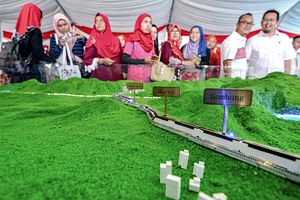In 2013, Chinese President Xi Jinping proclaimed the Belt and Road Initiative (BRI) in Kazakhstan and Indonesia. Since then, and even during the ongoing COVID-19 pandemic, the BRI – aimed at comprehensively strengthening policy, commercial, financial, infrastructural, and human connectivity – has been at the forefront of China’s economic diplomacy.
Among the over 130 countries that have formally acceded to the BRI cooperation framework, Malaysia emerges as a particularly interesting case study. Malaysia’s economic development has long been constrained by chronic underinvestment, including in its infrastructure sector. This has made cooperation with China attractive as Malaysia taps the “Going Out” efforts of Chinese firms eager to capture overseas order books.
Indeed, cumulatively from 2013 to 2018, Malaysia was the largest recipient of China-sourced investment and construction contracts in Southeast Asia, receiving some $35 billion according to data from the China Global Investment Tracker.
This trend heightened during the tenure of former Prime Minister Najib Razak, from 2009 to 2018. For the Najib administration, government-to-government collaboration with China became an especially popular platform to push its ambitious infrastructure endeavors. Some of the most prominent Chinese infrastructure projects were initiated during his tenure and continued under successive prime ministers, including the East Coast Rail Link (ECRL), Malaysia-China Kuantan Industrial Park (MCKIP), and Bandar Malaysia.
In research published in The Pacific Review, we conducted detailed case studies of the ECRL and MCKIP projects based on primary data collected during field trips to Malaysia, Hong Kong, and Singapore. The examination of these two flagship BRI-related infrastructure projects allows us to debunk three myths surrounding Chinese financial statecraft vis-à-vis Malaysia and other Southeast Asian countries more generally.
First, mainstream views tend to assume that there is a unique ‘‘central government–policy bank–state owned enterprise (SOE)’’ trinity that underpins most of China’s overseas BRI projects, while the Chinese state in the context of financial statecraft is often treated as a singular, unitary actor deprived of internal dynamics. Relatedly, it is conventionally held that the Chinese central government is firmly in the driver’s seat, functioning as the ‘‘brain’’ to dictate the external commercial behaviors of SOEs and provincial governments (the “arms”). We found these analytical presumptions and simplifications problematic in the case of Chinese infrastructure overture to Malaysia.
The Chinese central government might have been the major pusher of the ECRL project in part to keep Malaysia close to China while searching for alternative logistical routes to alleviate its overdependence on the strategic chokepoint of the Malacca Strait. Yet, provincial authorities (i.e., Guangxi province and provincial SOEs at its behest) are the key Chinese actors when it comes to the MCKIP. Guangxi province displayed entrepreneurial agency and political resolve in the advancement of the MCKIP project. Notably, thanks to familiarity with and understanding of the Malaysian culture, Guangxi province and investors from Guangxi upheld the principle of “In Malaysia, For Malaysia” in normal times and engaged in “mask diplomacy” at the height of the COVID-19 pandemic without explicit directives from Beijing. As such, one should be cautious when assuming away the multilayered nature of the Chinese state.
Second, in relation to Chinese state-business relations vis-à-vis Malaysia, we observed contrasting patterns between the ECRL and MCKIP. There is a top-down relationship in the case of the ECRL project. In this regard, one might recall that when former Prime Minister Mahathir Mohamad deferred the ECRL in August 2018, the Chinese contractor – China Communications Construction Company (CCCC) – initially demanded the project continue or compensation be paid. However, our analysis suggests that China’s powerful National Development and Reform Commission (NDRC) stepped in, paving the way for the subsequent renegotiation of the ECRL project. In return, the construction cost was cut significantly and the CCCC became a stakeholder with long-term interest in the undertaking. By contrast, the coordination mechanism in the MCKIP was noticeably more bottom-up. It was the provincial government and local SOEs that took the lead in the initiation and subsequent development of the project. The Chinese central government did not play an active role here, but offered political and diplomatic backing to MCKIP occasionally, in the form of high-level visits and inauguration ceremonies attended by high-ranking officials.
A third myth is the tendency to neglect how Chinese financial statecraft intermeshes with the politics of the host economy. Our research shows that the implementation of both the ECRL and the MCKIP has been heavily constrained by Malaysia’s political-institutional environment. As mentioned, the ECRL was (nearly) cancelled by the Malaysian government, with some horse-trading occurring behind the scenes before the project was revived. Even in the case of the MCKIP (which was less politicized in Malaysia and beyond), some controversy was created after Mahathir labelled the project a “Great Wall of China,” which seemingly created a foreign, differentiated ecosystem within Malaysian territory. Fortunately, the local Barisan Nasional (and some from the then-ruling Pakatan Harapan) political forces came to MCKIP’s rescue, helping it navigate the public relations fiasco. Given China’s experience with the ECRL and the MCKIP, it is increasingly clear that local political economy of the host nation is a crucial factor shaping the outcomes of Chinese financial statecraft.
As global economic growth’s center of gravity shifts further toward Asia in the post-COVID-19 era, the weight of China’s financial statecraft will likely expand. Understanding the multi-layered nature of the Chinese state, heterogenous Chinese state-business relations, and the interaction between Chinese capital exports and local political dynamics in BRI host countries will become even more important for scholars, business executives, and policymakers to make sense of a fast-changing regional and global order.
This article is based on the findings of a research paper published in The Pacific Review; an international relations journal covering the interactions of the countries of the Asia-Pacific. The Pacific Review has a particular interest in how the region is defined and organized, and covers transnational political, security, military, economic, and cultural exchanges in seeking greater understanding of the region.

































